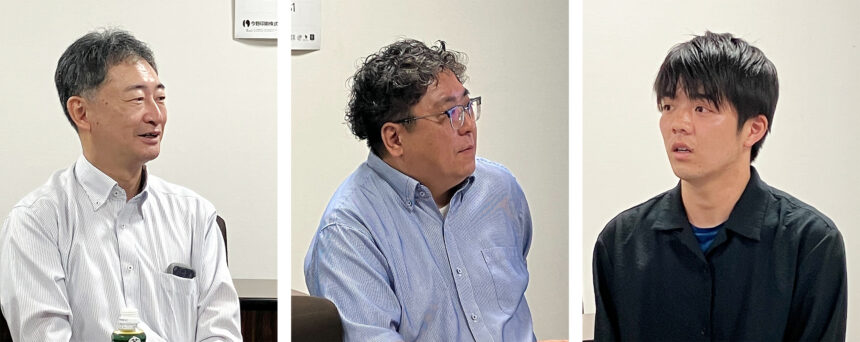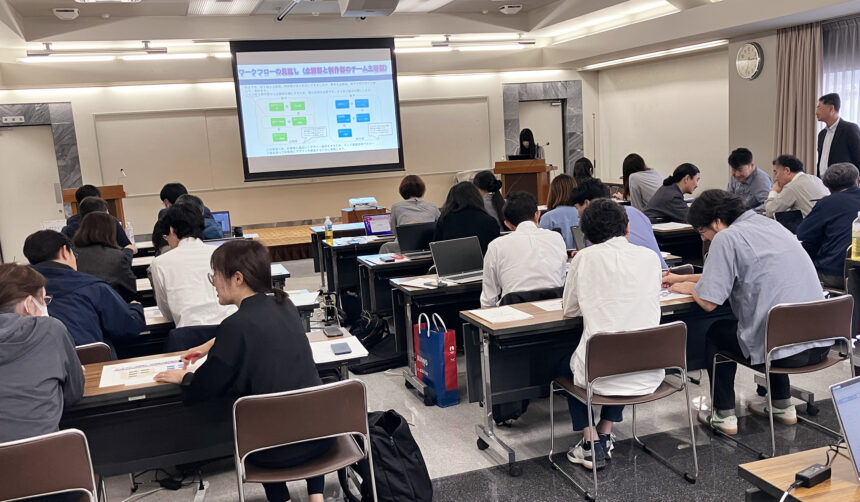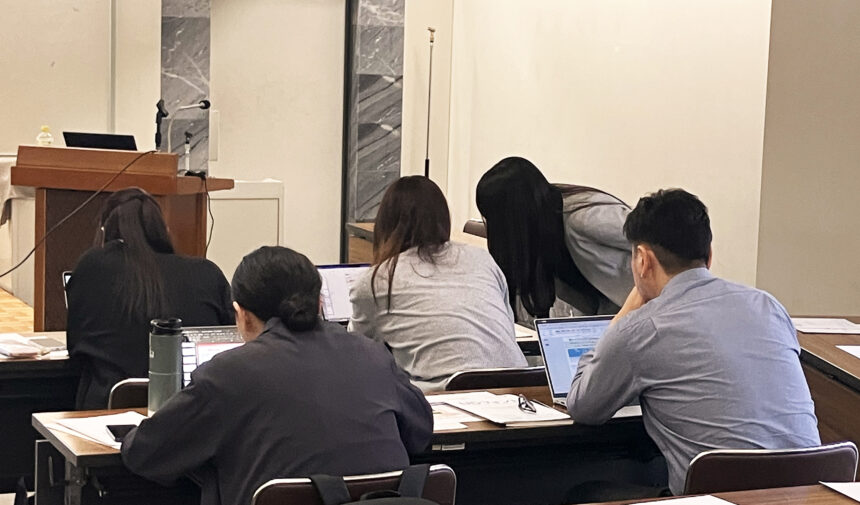
As times change, the roles expected of companies continue to evolve. In particular, for companies that are tasked with promoting their customers' information, there has been a major shift in focus to "how to communicate customer information accurately and attractively." Rather than simply creating something, one of the most important missions imposed on companies is to understand the "feelings" and "intentions" behind it and deliver it in the most optimal way.
This time, we spoke with President Hashiura, General Manager Kawauchi, and Mr. Ishikawa, who participated in the training, from Konno Printing Co., Ltd., a company with a history of over 100 years that continues to expand its business areas in response to modern needs. They told us about the reasons why they decided to take Morisawa's "Communicative" Document Design Program and the changes that have occurred within the company as a result of the training.

Our mission as a "communication partner" for the community
- Please tell us why you decided to take the "Communicative" Document Design Program.
President HashiuraIt goes without saying that the production department is adept at using fonts and designs. However, as customer requests become more diverse, we felt it was essential that all departments, including sales, planning, and digital-related personnel, share a common understanding of the keyword "design that communicates." We also aim to get deep into the hearts of our customers' businesses and work with them to create better services and products. To achieve this, no matter how good a plan or service you have, if it doesn't have the ability to communicate, its appeal won't reach the other party. We believe that creating materials that "communicate" is an important part of that, so we asked him to take this course.
- It was clear to see that Konno Printing is a company that grows together with its customers as their "communication partner."
Experience the feeling of "not being able to communicate" through concrete examples
- Designing materials that communicate effectively The program began with a group discussion using case studies.
Mr. IshikawaThe process of sharing "bad examples" with all participants and discussing what the problems were and how they could be improved was a great learning experience for the participants.
President HashiuraBy discussing and looking at concrete examples ranging from extreme cases that make you think "they would never actually do that" to common mistakes, we were able to reexamine our own methods. It was a great experience to realize that the same content can be communicated in a completely different way just by changing the way it is presented.
Konno Printing"Communicative" Document Design Program
[Part 1: Lectures and group work]
Participants shared their opinions in groups of two about the materials they normally create and the flaws in the materials they have been given. Afterwards, they were given specific examples to explain what they should pay attention to when creating materials that "communicate."

[Part 2: Work]
Using the know-how on creating materials that communicate effectively that they learned in Part 1, the participants actually remade assignments prepared by Morisawa and original materials created in-house. This was an opportunity to ask the instructor directly any questions they had about creating materials, and the conversation continued right up until the very last minute, making for a fulfilling workshop.

[Providing assignments and advice sheets after the course is over]
Any assignments that were not completed during the training must be submitted by the set deadline. After that, we will return the "advice sheet" with corrections to the submitted assignments, which you can refer to as reference material for future skill development.

The advice sheet helped participants realize how readability can be improved by adjusting the alignment of text and line spacing.
Awareness of "communication" changes daily work
- After the training, did you see any signs of change within the company?
Mr. IshikawaThe day after the training, I immediately decided to try using UD fonts when creating a project proposal. I work in the planning and sales department, so I'm always creating proposal documents, but I'd never really paid much attention to fonts before, so it was a refreshing experience to see how a change in appearance can make such a difference in how something is conveyed. I've also become more conscious of the other things I learned in the training, such as how to use color and consider the Z line of sight movement.
Until now, I have tended to create documents that condense information onto one page, but from now on, I would like to be more conscious of "communicating" to the other person, such as by making a distinction between what is shown and what is read. The advice sheet I received for the assignment materials I created during training was also very helpful in identifying specific areas for improvement. It made clear things I thought I was conscious of but was not able to do, and I think this will lead to future improvements.
Director KawauchiBy receiving objective opinions from external experts, we were able to make discoveries that we would not have noticed on our own.
President HashiuraAt Konno Printing, we have a corporate culture that encourages open discussions to produce better plans. By adding the perspective of design that communicates, we hope to further instill a customer-focused mindset within the company, further improving the quality of our plans and proposals and further strengthening our ability to make proposals to customers.
The success or failure of a proposal depends on the story and listening skills
"In order to put the knowledge I gained from this training into practice and bring about change for our customers, the most important thing is to be aware of how to communicate," says President Hashiura.
President HashiuraBefore creating a document, the most important step is to first formulate the content of "what should be communicated to the customer." It's like writing a story; you formulate the information that the other party "wants to know and hear" as a story, and then decide the importance and placement of the information according to that story. Without this process, no matter how skilled you are at using fonts, you won't end up with a document that resonates with people. To develop this "ability to formulate a story," it is essential to have the ability to listen to draw out the customer's true needs and the ability to organize the information that you have drawn out. A senior colleague once told me this."The true meaning of 'communicating' is to 'communicate' what the other person wants to know, not what you want to say."I feel that this saying is exactly the same when it comes to document design, and I believe that documents that "communicate" can only be created by not being self-centered, but by seeing things from the customer's perspective and being close to their hearts.
Adding value to information to become a trusted presence for customers
- If you can acquire the ability to "communicate," you will gain the trust of customers.
President HashiuraWe want our customers to feel that if they consult with Konno Printing, they will receive good proposals. Our goal is to build up that trust through our work.
- Konno Printing sells its own magazines and original greeting cards, and also develops smartphone apps. I felt that the customer experience cultivated through the operation of these end-user services is being utilized in making proposals from the customer's perspective.
Konno Printing's efforts to continually hone its ability to communicate across the entire company truly embody the company's new image of "breathing life into information."
"Communicative" Document Design: Expectations for the Program and the Future of Konno Printing
- Finally, please tell us your expectations for this training in the future.
Director Kawauchi Until now, this type of training has mostly been taken by individual production department staff or has been limited to software. By having staff from other departments take the course, we hope to make internal communication smoother in the future.
President HashiuraI think that every company has some concerns about creating planning and proposal materials that will "get through" to customers, so I would like to spread this know-how to a wide range of people.
We feel that the "Communicative" Document Design Program has transformed the awareness of each and every employee at Konno Printing and has been a powerful tool in improving our ability to propose ideas to customers. In particular, even those outside the production department have experienced the importance of being able to create "communicative" documents by acquiring a little skill and know-how. Furthermore, the fact that they have rediscovered the true essence of the act of "communicating" will be a great asset for future business development.
Please take a look at the page that provides detailed information about the "Communicative" Material Design Program Training (costs, process leading up to implementation, participant feedback, etc.).
If you are interested in the training sessions for the "Communicative" Material Design Program or the UD fonts used in the training sessions, or if you are considering introducing or utilizing them, please feel free to ask us any questions using the form below.

